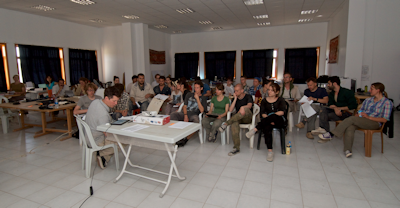
This second critique fits into a wider discussion that is connected to issues regarding the relative experience (both as excavators and as digital practitioners) of team members and the associated hierarchies and fault-lines of the site (Berggren and Hodder 2003; Chadwick 2003; Farid 2014; Lucas 2001; Shanks and McGuire 1996). As such we were particularly conscious that this might be a problem at the outset of the project's process of 'digitalisation'. The learning curve is steep in places and requires some knowledge and understanding of ArcGIS and other software – this simply cannot be avoided. As a requirement of the recording system workflow, all excavators at the site (whatever their ability or experience level as excavators) are required to record the archaeology using the GIS on the tablets. The inevitable result of this is that there is a real danger that certain individuals with an established technical GIS-based skill-set tend to dominate the digital recording on site.
This potential division of labour can result in a form of technologically orientated elitism where those archaeologists who are more tech-savvy dig less and record more. From an interpretative point of view this would be a step backwards, especially given that one of the key reflexive tenets of the project's methodology pushes for multivocality through the democratisation of the interpretative process (Hodder 2003). Indeed, as a barrier to multivocality, and with a tendency towards technological specialisation that may fragment an archaeological team, the careless application of technology in the field is also a disciplinary problem which deserves wider consideration as highly technological approaches become more prevalent in all aspects of archaeology.

In order to mitigate for this we have tried to take these issues into account whilst developing our methodology, primarily by making the workflow as straightforward and explicit as possible, and setting aside time for initial training of the team (Figure 16), so that every team member has a basic benchmark of technical understanding and ability of all practical aspects of the workflow, from on-site recording to back-up protocols. Nevertheless, there have remained limits to some team members' abilities to record using the tablet (and specifically the GIS), so it was necessary from the outset to start building a technical support network. To this end, during the initial training, individuals who showed an interest and aptitude for the more technical elements of the workflow were encouraged to become ad hoc 'trouble-shooters'. This was not an official role, so as to avoid constructing a further formalised technological hierarchy, but these individuals were given the support needed to solve the most recurrent problems in the workflow (and encouraged to feedback if they found legitimate short cuts or more efficient methods, thereby also tuning the workflows). Although specialists are required to structure the intra-site GIS initially and set up the tablets themselves, as well as assisting to a certain extent with the acquisition of 3D data, ultimately the result is a relatively non-hierarchical peer support network (which at Çatalhöyük functions in English, Turkish, Polish, Italian and Swedish – these being the dominant languages spoken by across the team).
To some extent many of these issues were compounded by the variability of archaeological (i.e. excavation as opposed to digital) skill-sets within the project. Whilst digital approaches do afford an opportunity to guide and prompt data input, thus potentially ensuring that key information is not missed, this directly juxtaposes the project's aim to allow more freedom in the generation of its primary data. The aim was not to impose an automated system of data entry and validation: rather than applying this type of mechanical constraint, we developed a series of workflows and protocols for the collation of data and mitigated against poor data acquisition through training workshops, the integration of varying skill levels and experiences in excavation teams (in terms of both digital and excavation experience), and a clear system of checking and validating data manually. In reality, technological elitism is fairly easy to resolve through training, and it may become less of an issue as more archaeologists become familiar with this kind of technology. However, it is important that we recognise the issue, as it requires resources and investment on the part of a project with a strong digital agenda, if the use of digital resources and tools is to be truly democratic.
Internet Archaeology is an open access journal based in the Department of Archaeology, University of York. Except where otherwise noted, content from this work may be used under the terms of the Creative Commons Attribution 3.0 (CC BY) Unported licence, which permits unrestricted use, distribution, and reproduction in any medium, provided that attribution to the author(s), the title of the work, the Internet Archaeology journal and the relevant URL/DOI are given.
Terms and Conditions | Legal Statements | Privacy Policy | Cookies Policy | Citing Internet Archaeology
Internet Archaeology content is preserved for the long term with the Archaeology Data Service. Help sustain and support open access publication by donating to our Open Access Archaeology Fund.